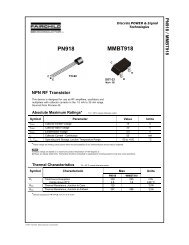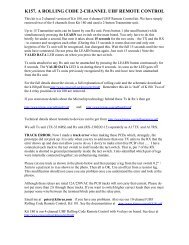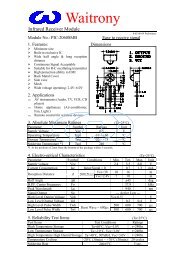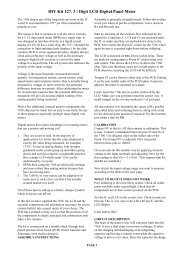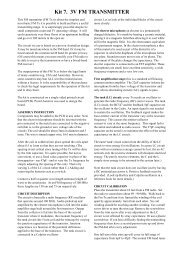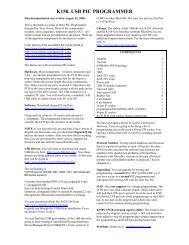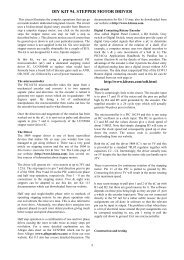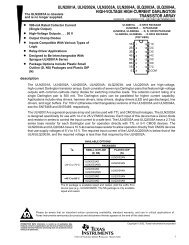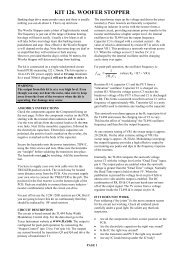K148T3. 40KHz Auto Ranging Frequency Meter - Ozitronics
K148T3. 40KHz Auto Ranging Frequency Meter - Ozitronics
K148T3. 40KHz Auto Ranging Frequency Meter - Ozitronics
You also want an ePaper? Increase the reach of your titles
YUMPU automatically turns print PDFs into web optimized ePapers that Google loves.
<strong>K148T3.</strong> <strong>40KHz</strong> <strong>Auto</strong> <strong>Ranging</strong> <strong>Frequency</strong> <strong>Meter</strong><br />
The third in a series of timer kits based on the K148<br />
hardware platform. This module will measure<br />
frequency up to <strong>40KHz</strong> in two ranges: above and below<br />
10KHz. Range switching is automatic. Output is via a<br />
4-digit 7-segment display.<br />
Refer to the “K148 4-DIGIT TIMING MODULE”<br />
documentation for details of hardware features, circuit<br />
description and assembly instructions.<br />
FREQUENCY METER SPECIFICATIONS<br />
Ranges<br />
0 to 9.999KHz<br />
10 to <strong>40KHz</strong> (approx)<br />
Gating Signal Internal<br />
0.1 second for < 10KHz<br />
1 second for > 10KHz<br />
Resolution 1Hz for < 10KHz<br />
10Hz for > 10KHz<br />
Inputs Start pins. LO, 0-0.9V; HI 1.2V –<br />
5.0V<br />
Output<br />
Open collector NPN transistor,<br />
100mA @ 30V<br />
Display<br />
4-digit 7-segment with decimal<br />
point, 14mm RED LED<br />
Supply voltage 9 to 12V DC<br />
Supply current 30 to 50mA, depending on the<br />
number displayed.<br />
Physical size 51mm x 66mm (2.0” x 2.6”)<br />
Connection 10-way right-angle SIL header<br />
pins, 0.1” spacing<br />
BASIC FREQUENCY MEASUREMENT<br />
THEORY<br />
Measuring frequency is a matter of counting the<br />
number of cycles in a given time interval. If the time<br />
interval is 1 second then the number of cycles counted<br />
is a direct reading of the frequency. The unit of<br />
frequency is Hertz (Hz) or ‘cycles per second’. This<br />
time interval is often referred to as ‘gate time’ or<br />
‘gating signal’.<br />
Using a 1 second gating signal is not always possible.<br />
The problem is in displaying the result. If using a 4-<br />
digit display, as in this kit, then the maximum display<br />
value is ‘9999’. If a 1 second gate signal was used then<br />
this limits the maximum frequency that can be<br />
displayed to 9999Hz (9.999KHz).<br />
This can be overcome by using more digits in the<br />
display. A 6-digit display can show up to 999999Hz<br />
(999.999KHz). What happens after that? You can’t go<br />
on simply tacking on more digits.<br />
The solution is to reduce the gate time, thereby<br />
reducing the number of counts. For example, assume<br />
we have a 4-digit display and we want to measure a<br />
10KHz signal. The result (10000) cannot be displayed<br />
in 4 digits. If the gating time is reduced to 0.1 seconds<br />
then the count value becomes ‘1000’ which can be<br />
displayed. Of course the actual frequency is ten times<br />
that.<br />
This now brings us to the problem of resolution. As can<br />
be seen from the previous example the last digit is<br />
‘lost’ when measuring a 10KHz signal. Therefore this<br />
is said to have a resolution of 10Hz because a 10Hz<br />
variation is required before the last display digit will<br />
change.<br />
If the signal is less than 10KHz we can use a 1 second<br />
gate time to measure it and still be able to display it<br />
fully. In this case the resolution is 1Hz because the<br />
display will change if the signal varies by that small<br />
amount.<br />
Gating signals are normally sub-multiples of 1 second,<br />
for example 0.1, 0.01, etc. This makes it easy to display<br />
the result – all we have to do is shift around the decimal<br />
point to indicate whether the reading is in Hz or KHz or<br />
MHz.<br />
Using gating times such as 0.2 or 0.5 seconds produces<br />
odd readings. For example if the gating time was 0.5<br />
seconds and the frequency being measured was 1KHz<br />
the reading would be 500. This may be desirable in<br />
some cases where a conversion is required between the<br />
actual measured signal and the displayed reading.<br />
OPERATING INSTRUCTIONS<br />
A frequency cycle is measured by a HI to LO<br />
transition at the START pair of pins. A HI is defined<br />
for the Atmel uC as 1.2V – 5.0V DC. A LO is 0.0V –<br />
0.9V DC.<br />
In other applications of firmware for k148 just shorting<br />
out the pins mechanically has been sufficient. However,<br />
in this case we are electrically short circuiting the pins<br />
so the voltage ranges must be specified.<br />
Connect a TTL level square wave signal (for example,<br />
from out Kit 101) to the ‘+’ start input pin and the<br />
module does the rest. Remember to common all ground<br />
connections.<br />
The kit uses two gate signals (ranges) to measure<br />
frequency. By default a 1 second gate signal (low<br />
range) is used on power up. If the frequency exceeds<br />
9999Hz then an internal ‘overflow’ condition occurs<br />
and the kit automatically switches to a 0.1 second gate<br />
signal (high range). When the frequency drops below<br />
10,000Hz it switches back to low range.<br />
The display reading is always in ‘KHz’, with the<br />
position of the decimal point indicating the range. In<br />
‘low’ range the maximum display reading is ‘9.999’<br />
KHz. In ‘high’ range the maximum display reading is<br />
’99.99’ KHz.<br />
The maximum frequency the kit can measure is<br />
around <strong>40KHz</strong>.<br />
Note: In low range the display only updates every<br />
second. In high range it updates every tenth of a<br />
PAGE 1
<strong>K148T3.</strong> <strong>40KHz</strong> <strong>Auto</strong> <strong>Ranging</strong> <strong>Frequency</strong> <strong>Meter</strong><br />
second. Low range is more accurate but high range will<br />
respond more quickly to frequency variations.<br />
The STOP pair of pins are NOT used in this module.<br />
The open collector output is ‘active’ when the counter<br />
is in high range. It can be used to drive an external light<br />
or LED to indicate that the input frequency is greater<br />
than 9999Hz. For more information about what an open<br />
collector output is read the note at<br />
www.kitsrus.com/zip/opencol.txt<br />
INPUT SIGNAL CONDITIONING<br />
Input to the kit is pulled high to 5 volts via a 10K<br />
resistor (refer to K148 schematic). It can be driven by<br />
any 5V logic output circuit. This is fine when working<br />
with digital circuits but that may not always be the case.<br />
What if we want to measure a low-level signal as found<br />
in audio preamplifiers? This may be as low as a few<br />
millivolts and therefore needs to be amplified and<br />
‘shaped’ before applied to the kit input.<br />
The figure shows a basic design for a simple,<br />
broadband preamplifier that could be used to condition<br />
the input signal before connecting to the counter input.<br />
There are many other circuits that could be used to do<br />
the job. This one is offered as an example.<br />
Q1 is a MOSFET that amplifies the input signal.<br />
Diodes D1 and D2 limit any excessive voltage so Q1<br />
will not be damaged. Q2 is a high-speed NPN transistor<br />
that further amplifies the signal to a level that will<br />
trigger the counter module. This circuit can easily be<br />
built on some perforated board. Keep lead lengths short<br />
to avoid oscillation.<br />
CONNECTING TO THE KIT<br />
A 10-way header strip provides external connection to<br />
the timer, including power. All the inputs and the<br />
output are organized as ‘pairs’ of pins, with each input<br />
or output having a corresponding ground pin, as per the<br />
following diagram.<br />
Note: When using the output to switch a load (relay,<br />
buzzer, etc) connect the load between the output pin<br />
and a positive DC voltage. For example, if switching a<br />
12V relay connect the relay between the output pin and<br />
+12V.<br />
OTHER TIMING MODULES<br />
There are other firmware ICs available for k148:<br />
1. K148T1 Simple Photographic Timer<br />
2. K148T2 Stopwatch with Pause function<br />
3. K148T0 Programmable Down Timer counting<br />
down in seconds from a maximum of 10,000 sec<br />
4. K148T4 Programmable Down Timer counting<br />
down in minutes from a max of 10,000 minutes<br />
5. K148T5 Programmable Down Timer counting<br />
down in hours from a max of 10,000 seconds<br />
See out website at www.kitsrus.com for details.<br />
If you have any questions or changes you can contact<br />
the kit developer at frank@ozitronics.com<br />
Please note we do not provide the source code for any<br />
of our firmware.<br />
PAGE 2



